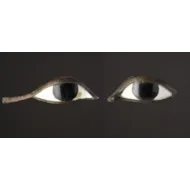Rare Pair of Over Life Size Ancient Egyptian Eye Inlays
A Rare Pair of Over Life Size Ancient Egyptian Eye Inlays
With pupils of black polished obsidian and whites of carved limestone encased in bronze probably from a royal funerary mask or statue
Good reddish brown patination to the bronze mounts
New Kingdom 1550 – 1070 BC
Size: 4.5cm high, 17cm wide, 6cm deep – 1¾ ins high, 6¾ ins wide, 2¼ ins deep
4.5cm high, 11cm wide, 4.5cm deep – 1¾ ins high, 4¼ ins wide, 1¾ ins deep
With pupils of black polished obsidian and whites of carved limestone encased in bronze probably from a royal funerary mask or statue
Good reddish brown patination to the bronze mounts
New Kingdom 1550 – 1070 BC
Size: 4.5cm high, 17cm wide, 6cm deep – 1¾ ins high, 6¾ ins wide, 2¼ ins deep
4.5cm high, 11cm wide, 4.5cm deep – 1¾ ins high, 4¼ ins wide, 1¾ ins deep
The art of making death or funerary masks was known as early as the Old Kingdom. Casts could be used as technical aids in making them for tombs and they were probably placed in the tomb to ensure that the deceased’s likeness should survive even if his mummy disintegrated. During the Middle Kingdom great care was taken with the appearance of mummies in this period and there was a growing use of funerary masks made of stuccoed cloth that were often gilded or painted yellow to imitate gold the ‘flesh of the gods’. This practice contributing to the deification of the deceased.
In the New Kingdom the use of anthropoid coffins became the rule with the mummy mask often having eyebrows and eyes inlaid with glass paste rather than painted as earlier wealthy individuals often copied royalty by having three coffins besides a sarcophagus that could be of stone or wood, but only the Pharaohs had funerary masks made of solid gold with carefully sculpted eyes of carved limestone and polished obsidian reflecting as a mirror the objects around them and giving a sense of immortality.
These large eyes probably also served to represent the ‘Udjat’ eyes of the falcon god Horus and would serve as protective symbols to ward off perils on the mummies dangerous journey to the underworld.
In the New Kingdom the use of anthropoid coffins became the rule with the mummy mask often having eyebrows and eyes inlaid with glass paste rather than painted as earlier wealthy individuals often copied royalty by having three coffins besides a sarcophagus that could be of stone or wood, but only the Pharaohs had funerary masks made of solid gold with carefully sculpted eyes of carved limestone and polished obsidian reflecting as a mirror the objects around them and giving a sense of immortality.
These large eyes probably also served to represent the ‘Udjat’ eyes of the falcon god Horus and would serve as protective symbols to ward off perils on the mummies dangerous journey to the underworld.
Rare Pair of Over Life Size Ancient Egyptian Eye Inlays

SOLD
